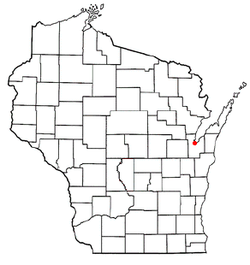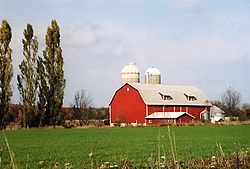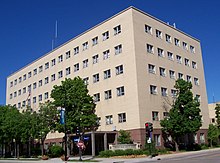Green Bay, Wisconsin
It has been suggested that Green Bay Police Department be merged into this article. (Discuss) Proposed since June 2007. |
Green Bay, Wisconsin | |
|---|---|
 | |
| County | Brown |
| Government | |
| • Mayor | James J. Schmitt, (R) |
| Population (2006) | |
| • City | 102,313 |
| • Metro | 226,778 |
| Time zone | UTC-6 (Central) |
| Website | City of Green Bay Official Website |
Green Bay is the county seat of Brown County in the U.S. state of Wisconsin. The city is located at the head of the Bay of Green Bay and the mouth of the Fox River, at an altitude of 581 feet (177 m). It is 112 miles (180 km) north of Milwaukee. According to the 2004 census estimate, Green Bay has a population of 102,313. The Town of Green Bay is located several miles northeast of the city.
Green Bay is the third largest city in Wisconsin. It is set at the southern end of Green Bay and is divided by the Fox River. Green Bay is an industrial city with several meatpacking and paper plants. Downtown Green Bay is the area surrounded by Walnut, Monroe, and Main Avenues. The Fox River acts as a natural border for the downtown. Downtown Green Bay has a number of mid-rise buildings and the now defunct Port Plaza Mall. Lambeau Field is located in the southeastern part of the city on Lombardi Avenue. South of downtown on Monroe Avenue lays the South Village Historical District. The neighborhood is contains large old homes and tree lined streets. The district is located south of Mason Avenue on Monroe.
The city of Green Bay is a port on the Bay of Green Bay, an arm of Lake Michigan. Green Bay is home to the National Railroad Museum, the Neville Public Museum with exhibitions of art, history, and science, and to the University of Wisconsin-Green Bay.
The Green Bay Packers professional football team has been based in the city since 1919. Green Bay is the smallest city presently to have an NFL franchise, and the team is the city's claim to fame.
Green Bay is the smallest US market for a major professional sports team of any kind, although the Packers' fanbase stretches across the state of Wisconsin and beyond. Green Bay is nicknamed "Titletown, USA" for the number of NFL titles (12) it has won over the years (including the first two Super Bowls as well as Super Bowl XXXI). An afl arena football franchise, the Green Bay Blizzard, was recently awarded to the city.
Green Bay metropolitan area forms the core of the United States Census Bureau's Green Bay Metropolitan Statistical Area, which includes all of Brown County (2004 population: 237,166).
Neighborhoods
You must add a |reason= parameter to this Cleanup template – replace it with {{Cleanup|section|reason=<Fill reason here>}}, or remove the Cleanup template.
Green Bay is a diverse city with several different neighborhoods.
Downtown Green Bay is the heart of the city. There are several mid rise office buildings and churches downtown. The Brown County Court House is located in the heart of downtown. The riverfront has seen a great amount of redevelopment with several new loft projects. A 17 story condominium project is planned for the riverfront. Downtown Green Bay is also home to the now defunct Port Plaza Mall. The downtown has experienced new streetscaping lately in an attempt to fill in downtown storefronts.
Across the river from downtown Green Bay is the Broadway District. The district is located on Broadway Street. There are several shops and restaurants located within the District. Titletown Brewery and the Neville Public Museum are located in the area. The neighborhood is now experiencing residential development.
The near west side is a middle class neighborhood with large homes and tree lined streets. Ashland Avenue is the main street in the neighborhood. Located just west of the Broadway District, the area is becoming a popular place to live.
The west side is largely middle class and comprised of basic wood homes. The area has a very residential feel and has few businesses. Locust Street marks the end of the west side neighborhood.
The near east side is lower middle class residential. There are several large plants and warehouses in the area. The neighborhood is Green Bay's most blighted. The streets are home to large trees and traditional wood homes.
The far east side is lower middle to middle class. There are several new housing developments in the area. The neighborhood has a newer and blander feel to it. The area is a mix of residential and commercial with several new strip malls and suppermarkets.
South of downtown lies the South Village Historical District. This is the city of Green Bay's most affluent neighborhood. The neighborhood is home to several large homes and beautiful tree lined streets. The neighborhood is just south of Mason Street. To the south of the neighborhood is the suburb of Allouez.
History


A small trading post was established at this location in 1634 by French-Canadian explorer Jean Nicolet. In 1671 a Jesuit Mission was set up here; at the time the settlement was known as La Baye or la Baie des Puants. A fort was added in 1717. The town was incorporated in 1754, and was passed to British control in 1761. As British settlers in the area came to outnumber the French, the name "Green Bay" became the more common name for the town. In 1783 the town became part of the United States of America.
The United States Army built Fort Howard on the banks of the Fox River in 1816. Wisconsin's first newspaper, The Green Bay Intelligencer, was first published here in 1833. By 1850 the town had a population of 1,923. The town was reincorporated as the city of Green Bay in 1854. The Green Bay Area Public School District was founded in 1856. The railroad arrived in the 1860s. By 1950 the city had a population of 52,735.
Geography

According to the United States Census Bureau, the city has a total area of 140.7 km² (54.3 mi²). 113.6 km² (43.9 mi²) of it is land and 27.1 km² (10.4 mi²) of it is water. The total area is 19.24% water.
Climate
The city of Green Bay experiences a continental climate, moderated slightly by the city's proximity to Lake Michigan. The city's climate features four distinct seasons, with warm, frequently hot summers and long, cold and snowy winters. The variance in temperature and precipitation between months is severe and often extreme. The warmest month is July, when the average high temperature is 81°F (28°C). During July, the average low temperature is 59°F (15°C). The coldest month of the year is January, when the high temperature averages only 24°F (-5°C), and the low temperatures average 7°F (-14°C).
The wettest month in Green Bay is August, when 3.77 inches (95.8mm) of precipitation falls, mostly in the form of rainfall from thunderstorms. The driest month in Green Bay is February, when the majority of precipitation falls as low moisture-content snow due to cold, dry air. On average, only 1.01 inches (25.7mm) of precipitation falls in February.
| Monthly Normal and Record High and Low Temperatures | ||||||||||||
| Month | Jan | Feb | Mar | Apr | May | Jun | Jul | Aug | Sep | Oct | Nov | Dec |
|---|---|---|---|---|---|---|---|---|---|---|---|---|
| Rec High °F | 53 | 61 | 78 | 89 | 91 | 98 | 103 | 99 | 95 | 88 | 74 | 64 |
| Norm High °F | 24.1 | 28.9 | 40 | 54.6 | 68 | 76.8 | 81.2 | 78.5 | 70.2 | 57.9 | 42.4 | 29 |
| Norm Low °F | 7.1 | 12.1 | 22.6 | 33.9 | 44.7 | 54 | 58.6 | 56.5 | 47.5 | 36.9 | 25.6 | 13.3 |
| Rec Low °F | -31 | -28 | -29 | 7 | 21 | 32 | 40 | 38 | 24 | 15 | -9 | -27 |
| Precip (in) | 1.21 | 1.01 | 2.06 | 2.56 | 2.75 | 3.43 | 3.44 | 3.77 | 3.11 | 2.17 | 2.27 | 1.41 |
| Source: USTravelWeather.com [1] | ||||||||||||
Transportation

Green Bay is served by Austin Straubel International Airport. The city was the headquarters of the Green Bay and Western Railroad in historical times (1896-1993). Green Bay also has its own mass transit system of buses known as Green Bay Metro (formerly known as Green Bay Transit).
Demographics
| City of Green Bay Population by year [1] | |
| 1855 | 1,644 |
| 1860 | 2,276 |
| 1870 | 4,698 |
| 1880 | 7,476 |
| 1890 | 9,069 |
| 1900 | 23,748 |
| 1910 | 25,216 |
| 1920 | 31,643 |
| 1930 | 37,407 |
| 1940 | 46,205 |
| 1950 | 52,735 |
| 1960 | 62,952 |
| 1970 | 87,829 |
| 1980 | 87,947 |
| 1990 | 96,466 |
| 2000 | 102,313 |
| 2005 | 99,032 |
As of the 2005 U.S. census estimate, there are 102,313 people residing in Green Bay. The Greater Green Bay Area consists of 279,485 people as of the 2000 census, there were 141,591 households, and 124,663 families residing in the city. The population density is 900.5/km² (2,332.1/mi²). There are 43,123 housing units at an average density of 379.5/km² (982.9/mi²). The racial makeup of the city is 85.86% White, 1.38% African American, 3.28% Native American, 3.76% Asian, 0.04% Pacific Islander, 3.72% from other races, and 1.97% from two or more races. 7.13% of the population are Hispanic or Latino of any race. Many of the Asian Americans are Hmongs.
There are 41,591 households out of which 30.6% have children under the age of 18 living with them, 44.1% are married couples living together, 10.8% have a female householder with no husband present, and 40.7% are non-families. 31.6% of all households are made up of individuals and 9.9% have someone living alone who is 65 years of age or older. The average household size is 2.40 and the average family size is 3.06.

City demographics are as follows: 25.4% are under the age of 18, 11.6% from 18 to 24, 31.7% from 25 to 44, 19.5% from 45 to 64, and 11.8% who are 65 years of age or older. The median age is 33 years. For every 100 females there are 97.2 males. For every 100 females age 18 and over, there are 94.8 males.
The median income for a household in the city is $38,820, and the median income for a family is $48,678. Males have a median income of $33,246 versus $23,825 for females. The per capita income for the city is $19,269. 10.5% of the population and 7.4% of families are below the poverty line. Out of the total population, 12.7% of those under the age of 18 and 9.2% of those 65 and older are living below the poverty line.
The city is noted for having one of the lowest crime rates in the United States for a municipality its size or larger.
Religion

The city is the seat of the Roman Catholic Diocese of Green Bay, under the direction of Bishop David Allen Zubik. The Cathedral of Saint Francis Xavier in Green Bay is the mother church of the Diocese. The diocese is in the province of the Archdiocese of Milwaukee. In 2000, the American Religion Data Archive reported Green Bay to be predominantly Catholic (71.5%), with Lutherans composing an additional 16.4%. The remaining 12% are almost entirely protestant denominations.
Media
Green Bay is served by the Green Bay Press-Gazette. Another local paper, the Green Bay News-Chronicle ceased publication in 2005.
Points of interest


- Bay Beach Amusement Park
- Bay Park Square
- Brown County Veterans Memorial Arena
- City Stadium, former home of the Packers
- Cofrin Memorial Arboretum
- East Town Mall
- Fort Fun
- Green Bay Botanical Garden
- The Broadway District[2]
- Green Bay Net local wi-fi and web development
- Heritage Hill State Park[3]
- KI Convention Center
- Lambeau Field, home of the Green Bay Packers
- Kastle Carts
- Meyer Theater
- National Railroad Museum
- Neville Public Museum[4]
- Northeast Wisconsin Technical College (NWTC)[5]
- NEW Zoo
- Resch Center, home of the Green Bay Blizzard in neighboring Ashwaubenon.
- ShopKo Hall
- Tundra Lodge Resort & Waterpark
- University of Wisconsin-Green Bay (UWGB)
- Weidner Center
Famous residents
- John Anderson ESPN Sportscenter anchor attended Southwest High School
- Ken Anderson, Professional Wrestler currently working in the WWE under the name Ken Kennedy.
- Dan Buenning, guard for the NFL team, the Tampa Bay Buccaneers; attended Bay Port High School.
- Jay DeMerit, player for Watford F.C. in the Football League Championship, England; attended Bay Port High School.
- Pat MacDonald, singer in Timbuk3.
- Nick Mortensen comedian went to Southwest High School currently residing in Madison but said to still own a house in Hobart just outside of Green Bay
- John W. Reynolds, Governor of Wisconsin.
- Tony Shalhoub of the TV series, Monk; attended Green Bay East High School.
- Zack Snyder, director of Dawn of the Dead (2004) and 300.
- Aaron Stecker, running back for the NFL team, the New Orleans Saints; attended Ashwaubenon High School.
- Margaret Teele (Margaret Poby)1960s TV and movie actress, attended St. Joseph's Academy (now Notre Dame Academy).
- Bob Wickman Major League Baseball pitcher for the Atlanta Braves.
- Kellan Quinn; Philanthropist
Mayors
Schools
- High Schools
- School of Higher Education
Photos of Green Bay
-
Downtown Green Bay
-
South Village Historical District
-
Downtown Green Bay
-
Brown County Court House
-
Downtown Green Bay
-
Downtown Green Bay YMCA
-
The Broadway District
-
a downtown church
-
a downtown church
-
Large South Side home
-
The near west side of Green Bay
-
A Green Bay Television Station
-
A downtown office building
-
East Main Street in Green Bay
-
The east side of Green Bay

